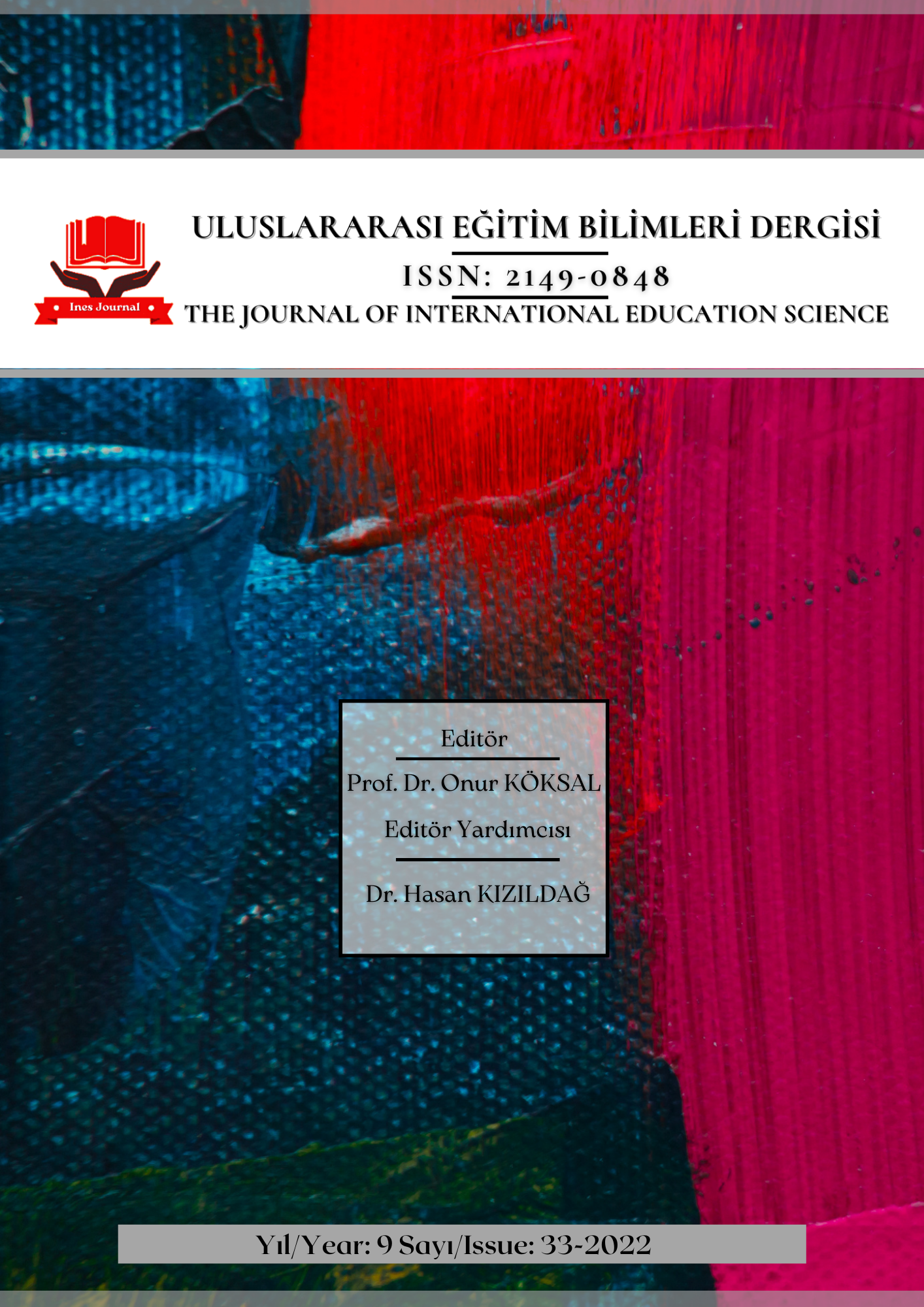Teknoloji Destekli Kuadratik Yüzeyler Öğretiminin Matematik Öğretmenliği Lisans Öğrencilerinin Eleştirel Düşünme Becerilerine Etkisinin İncelenmesi
Author :
Abstract
İnsanın en önemli özelliği düşünme yeteneğinin olmasıdır. Okullarımızda gördüğümüz eğitimin en önemli amaçlarından biri bireyin düşünme yeteneğinin geliştirebilmesini sağlayabilmektir. Matematik eğitiminde, farklı düşünme becerilerinin gelişimine önem verilmektedir. Eleştirel düşünme, matematik derslerinde problem çözümlerinde kullanılan düşünme becerilerinden birisidir. Eleştirel düşünmenin gerçekleşebilmesi için çeşitli yöntemler kullanılmaktadır. Çalışmamızda son yıllarda teknolojinin hızla gelişip eğitim hayatımızın bir parçası durumuna gelmesiyle, teknoloji destekli öğretimin matematik öğretmenliği öğrencilerinin eleştirel düşünme becerilerine etkisinin incelenmesi amaçlanmaktadır. Çalışmamızda nicel ve nitel araştırma yöntemlerini birlikte kullandığımız karma yöntem seçilmiştir. Matematik öğretmenliği öğrencilerinin seçiminde amaçsal örneklem yöntemi tercih edilmiştir. Çalışmamıza başlamadan önce başarı testine göre 6 öğrenci seçilmiştir. Geogebra yazılımı uygulanarak teknoloji destekli matematik öğretimi gerçekleştirilmiştir. Öntest-sontest olarak Eleştirel Düşünme Eğilimi Ölçeği (Semerci 2016) uygulanmıştır. Elde edilen verilere göre öğrencilerin eleştirel düşünme eğilimlerinde artış gözlemlenmiştir. Ayrıca uygulama sonrasında Kuadratik yüzeyler konusu ile ilgili olarak Gerçek Yaşam Problemler Etkinliği uygulanarak öğrencilerin eleştirel düşünme bileşenleri kriterlerine göre değerlendirme yapılmıştır.
Keywords
Abstract
The most important characteristic of a human being is the ability to think. One of the most important aims of the education we receive in our schools is to enable the development of mental thinking skills. In the education of mathematics, importance is given to the use of different thinking elements. Critical thinking overcomes the thinking skills used in solving problems in mathematics lessons. It is used for diversification to realize critical thinking. In our study, it is aimed to examine technology-assisted teaching as a result of critical thinking skills of mathematics teaching curricula, with rapid development being achieved as a part of education in recent years. In our study, quantitative and qualitative research methods are classified as mixed method using together. The sampling method was preferred for the learning of mathematics teaching students. Before working on our study, 6 students were selected according to the achievement test. Technology supported mathematics teaching was carried out by applying Geogebra software. Critical Thinking Disposition Scale (Semerci 2016) was applied as pretest-posttest. According to what has been obtained, a number of their critical thinking styles have been observed. In addition, after the application, Real Life Problems Activity was applied on the subject of Quadratic surfaces and an evaluation was made according to the criteria by which the students evaluated critical thinking.
Keywords
- Alp, G. (2019). Scratch programı ile web destekli işbirlikli öğrenme yönteminin ilkokul 5. sınıf öğrencilerinin kavramsal anlama düzeylerine ve eleştirel düşünme becerilerine etkisi [Yayınlanmamış yüksek lisans tezi]. Uludağ Üniversitesi.
- Ayrancı Açıkgöz, S.(2011). İlköğretim öğrencilerinin eleştirel düşünme becerileriyle matema- tik başarıları arasındaki ilişki [Yayınlanmamış yüksek lisans tezi]. Ankara Üniversitesi Eğitim Bilimleri Enstitüsü İlköğretim Anabilim Dalı Matematik Eğitimi.
- Baki, A. (2008). Kuramdan uygulamaya matematik eğitimi, (Genişletilmiş 4. Basım). Harf Eğitim Yayıncılığı.
- Büyüköztürk Ş., Kılıç Çakmak E., Akgün Ö. E., Karadeniz Ş. ve Demirel F. (2018). Eği- timde bilimsel araştırma yöntemleri, (25. Baskı). Pegem Akademi. Çelikkaya, T. (2012). Sosyal bilgiler dersinde öğrencilerin eleştirel düşünme becerilerini geliştirmek için öğretmenlerin yaptıkları etkinlikler. International Journal Of Social Scince, 5(5), 57-74.
- Çörekçioğlu, M. S. (2019). Matematik öğretmenlerinin ve öğrencilerin GeoGebra yazılımının kullanılması hakkındaki görüşlerinin incelenmesi [Yayınlanmamış yüksek lisans tezi]. Atatürk Üniversitesi.
- Facione, P. (1998). Critical thinking: What it is and what it counts. California Academic Press.
- Facione, P. (2011). Critical thinking: What it is and why it counts. https://www.student.uwa.edu.au/__data/assets/pdf_file/0003/1922502/CriticalThinking-What-it-is-and-why-it-counts.pdf.
- Fırat, M., Kabakçı Yurdakul, I. ve Ersoy, A. (2014). Bir eğitim teknolojisi araştırmasına dayalı olarak karma yöntem araştırması deneyimi. Eğitimde Nitel Araştırmalar Dergisi, 2(1), 64-85.
- Gürkaynak, İ., Üstel F. ve Gülgöz, S. (2003). Eleştirel düşünme, (3. Baskı). Eğitim Refor- mu Girişimi.
- Gürsan, S., Broutın, M. S. T. ve İpek, J. (2021) Eleştirel düşünme becerilerini geliştir- meye yönelik tasarlanan teknoloji destekli öğretim uygulamalarına ilişkin öğretmen adaylarının görüşleri. Uludağ Üniversitesi Eğitim Fakültesi Dergisi, 34(2), 703-744.
- Hacıömeroğlu, S. E., Bu, L., Schoen, R.,C., & Hohenwarter M. (2009). Learning to deve- lop mathematics lessons with GeoGebra. MSOR Connections, 9(2), 24-26.
- Harari, Y. N. (2018). 21.yüzyıl için 21 ders. Kolektif Kitap.
- İşman A., (2005). Öğretim teknolojileri ve materyal geliştirme, (1.Baskı). Pegem-A Yayıncı- lık. Milli Eğitim Bakanlığı (2018). 2023 eğitim vizyonu. Erişim adresi: http://2023vizyonu.meb.gov.tr/doc/2023_EGITIM_VIZYONU.pdf (17.01.2020).
- Milli Eğitim Bakanlığı (MEB). (2018). Matematik dersi öğretim programı. http://mufredat.meb.gov.tr/Dosyalar/201813017165445MATEMAT%C4%B0K%20% C3%96%C4%9ERET%C4%B0M%20PROGRAMI%202018v.pdf. (12.09.2022).
- Karabey, B .(2010). İlköğretim üstün yetenekli öğrencilerin yaratıcı problem çözmeye yönelik erişi düzeylerinin ve kritik düşünme becerilerinin belirlenmesi [Yayınlanmamış Doktora Tezi]. Dokuz Eylül Üniversitesi.
- Karataş, İ. ve Güven, B. (2003). Problem çözme davranışlarının değerlendirilmesinde kullanılan yöntemler: Klinik mülakatın potansiyeli. İlköğretim-Online, 2(2), 2-9
- Kökdemir, D. (2003). Belirsizlik durumlarında karar verme ve problem çözme (Yayın- lanmamış Doktora Tezi) Hacettepe Üniversitesi. Soylu, Y. ve Soylu, C. (2006). Matematik derslerinde başarıya giden yolda problem çözmenin rolü. İnönü Üniversitesi Eğitim Fakültesi Dergisi, 7(11), 97-111.
- Ozan, C. (2009). İlköğretim sınıf öğretmenlerinin eğitim teknolojileri açısından yeterlilikleri (Erzurum ili örneği) [Yayınlanmamış Yüksek Lisans Tezi]. Atatürk Üniversitesi, Sosyal Bilimler Enstitüsü.
- Semerci, N. (2016). Eleştirel düşünme eğilimi (ede) ölçeğinin geliştirilmesi: geçerlik ve güvenirlik revize çalışması. Electronic Turkish Studies, 11(9). http://dx.doi.org/10.7827/TurkishStudies.
- Türnüklü, E. ve Yeşildere, S. (2005). Türkiye’den bir profil:11-13 yaş gurubu matematik öğretmen adaylarının eleştirel düşünme eğilim ve becerileri. Ankara Üniversitesi Eğitim Bilimleri Fakültesi Dergisi, 38(2), 167-185.
- Eleştirel düşünme becerileri nedir ve nasıl geliştirilir? (2022, 15 Kasım). https://www.matematiksel.org/elestirel-dusunme-becerileri-nasil-gelistirilir.





